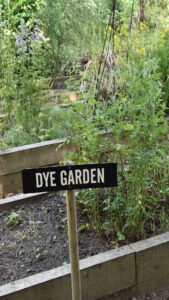At the back of the Archive, we have a dye garden with dye plants that would have been used in the Mill during the time Edwin Woodhouse was the mill owner. Before the onset of synthetic dyes, natural dyes were used in the textile industry. Such as the dye logwood which is made for the bark of a Caribbean tree to make the colour black. However, there are many plants used for dyeing which can be found much closer to home such as chamomile used to make the colour yellow and iris used to make the colour purple.

The dye garden over the past few months has seen an influx of weeds so our wonderful green-fingered volunteers are starting to tackle the borders to find out what dye plants are still surviving. The aim of the garden is to educate people on the plants used in natural dyeing and the colours that would be produced. In the Archive collection, we have dye guard books that contain samples of natural dyeing that took place at the Mill in the 1800s. They also show the unique point in time that the industry began to experiment with synthetic dyes during the Industrial Revolution.
If you are interested in finding out more about natural dyeing we are running dye workshops here at the mill, why not book yourself on.
https://www.sunnybankmills.co.uk/calendar/category/courses-and-workshops/
Back To Blog Next (Billy Gaunt) Prev (Material Matters Artist in Residence: Jenny Handley #2)
Tags
Museum & Archive Arts & Culture Regeneration General
